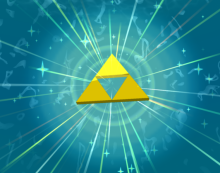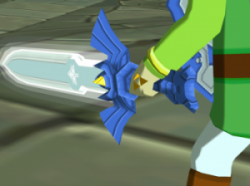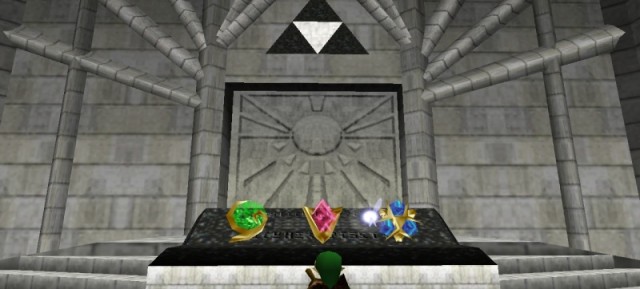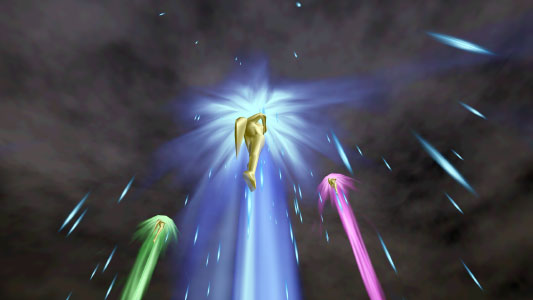Importance of the Number Three
Posted on October 05 2012 by Djinn
 There has been a large number of recurring objects, themes, and characters in the Legend of Zelda series. More often than nearly any other number or symbol, the number three appears to have the most significance in the Zelda series, and as I will discuss later, other places as well. It is such an important attribute that many things involving it, great and small, are very noticeable, and its symbolism can be seen in both the series’ gameplay and its mythology. The foremost example is the Triforce. After the first game, the concept behind the Triforce would be expanded to have a profound influence upon the peoples that live in Hyrule.
There has been a large number of recurring objects, themes, and characters in the Legend of Zelda series. More often than nearly any other number or symbol, the number three appears to have the most significance in the Zelda series, and as I will discuss later, other places as well. It is such an important attribute that many things involving it, great and small, are very noticeable, and its symbolism can be seen in both the series’ gameplay and its mythology. The foremost example is the Triforce. After the first game, the concept behind the Triforce would be expanded to have a profound influence upon the peoples that live in Hyrule.
The Triforce itself consists of three golden triangles of incredible divine power, left by the three deities that created the world upon completion of their work. Each piece is named for and represents a fundamental force or virtue that is important to the people living within the world: Power, Wisdom, and Courage. The Triforce is the primary artifact that all of the culture of Hyrule is centered around; the familiar triple triangle symbol is seen throughout much of the countryside and can be spotted in even the most mundane of places. The triangle has become a holy symbol signifying the religion of the Hylian people and a lucky charm worn by many. Not only serving as the main object of worship and admiration, the Triforce is also acquired by many of the main characters. It is said to grant the wish of anyone who places their hands upon it. Each individual piece, while not as powerful, still grants the owner incredible abilities. Ganondorf’s lust for the power it provides has been his main motivation as well as the source of conflict within the story of several games.
Nayru, the Goddess of Wisdom, Din, the Goddess of Power, and Farore, the Goddess of Courage, are responsible for the creation of the Triforce. The goddesses themselves are represented by three colors: Green for Farore, red for Din, and blue for Nayru. The goddesses play almost no direct part in the story of any of the games outside of the creation backstory. However, their influence is easily noticed throughout the series. Each piece of the Triforce is named for the major attribute of each goddess. The provinces of Lanayru, Eldin, and Faron, as well as their guardian spirits, contain the names of the goddesses. The spells Nayru’s Love, Din’s Fire, and Farore’s Wind are named for the goddesses. Eventually, even the elements of forest, fire, and water have each come to be equated to a corresponding goddess as well as the people or race with a particular affinity for that specific element.
The virtues that each piece of the Triforce is named after are symbolized by each goddess. Often, Link must prove his worth as a hero or undergo some form of trial before he can acquire the Master Sword or even the Triforce itself. The three virtues of Power, Wisdom, and Courage are of incredible importance to the culture of Hyrule as it is often said that a true hero must have a balance of all three. Many times, each virtue has a specific test that Link must complete to show that he learned it over the course of his adventure. Occasionally, Link is awarded for completing these trials with some symbol, starting out with the three pendants of virtue in A Link to the Past that prove he has power, wisdom, and courage enough to be worthy of drawing the Master Sword. In Ocarina of Time, the pendants are replaced with the three spiritual stones that hold a similar purpose for drawing the Master Sword and opening the Door of Time to the sacred realm. In The Wind Waker, the three goddess pearls have the same function.
The central characters of the series — Link, Zelda, and Ganondorf — have also come to represent the three central virtues of the Triforce. Each one has kept the piece of the Triforce that they have the strongest connection to, and they often play out the balance between power, wisdom, and courage. Link is the courageous youth that must overcome the many hardships of his quest to save the kingdom. Zelda is the wise ruler of the nation and has been a central background figure to the story. Ganondorf was the power hungry ruler of a desert tribe that lusted after the Triforce and wants to rule the world. Link is courageous but headstrong and often foolish; Zelda is wise and knowledgeable but weak and often captured by stronger enemies; and Ganondorf is powerful but is defeated by those brave enough to defy him. All of the characters epitomize their virtue in both strength and weakness.
 The country of Hyrule is often divided between certain ecosystems and peoples that also represent an aspect of the Triforce. In Ocarina of Time, the Kokiri living within the forest represent Farore, the Gorons of Death Mountain represent Din, and the Zora of the waters represent Nayru. Each tribe within this installment possesses a sacred spiritual stone that is shaped after the symbol of their people. In the case of the Kokiri Emerald and the Zora’s Sapphire, they also correspond to the symbols of the goddesses Farore and Nayru. Each of these races take on an aspect of their patron goddess and signifying color. In later games, these same tribes do not always appear, but the regions such as forest, water, and mountain are usually still significant to the specific goddesses in some way. On a few occasions, they lie within provinces that are named for the goddesses.
The country of Hyrule is often divided between certain ecosystems and peoples that also represent an aspect of the Triforce. In Ocarina of Time, the Kokiri living within the forest represent Farore, the Gorons of Death Mountain represent Din, and the Zora of the waters represent Nayru. Each tribe within this installment possesses a sacred spiritual stone that is shaped after the symbol of their people. In the case of the Kokiri Emerald and the Zora’s Sapphire, they also correspond to the symbols of the goddesses Farore and Nayru. Each of these races take on an aspect of their patron goddess and signifying color. In later games, these same tribes do not always appear, but the regions such as forest, water, and mountain are usually still significant to the specific goddesses in some way. On a few occasions, they lie within provinces that are named for the goddesses.
Later on, the three ecosystems or provinces of Hyrule are also each host to a lesser guardian deity that take on the aspects of one of the three goddesses. Each one is the protector of the region and often guards some sacred item or secret important to the game and the golden goddesses in some way. In The Wind Waker, it’s the Great Deku Tree who lives in the forest, Jabun of the water, and the dragon Valoo, who lives on the top of a fiery mountain. In Skyward Sword there are three dragons, one living within each province and taking on the role of a servant to the gods. They are named for the province they protect but within each name is the familiar goddess names of Din, Nayru, or Farore. There are also great fairies that aid Link on his journey. Often, they are named for the three virtues of the Triforce, instead of having names of their own or taking on a similar name to the goddesses such as the dragons of Skyward Sword and light spirits of Twilight Princess.
There have been a great number of various smaller coincidences within the series that are also represented by or come in threes. One such example is the fact that in nearly every game before Skyward Sword, Link begins with only three hearts. The number of saved games allowed in most games is three. The Moon over Termina falls after only three days, forcing Link to repeat and relive the same three days until the quest is complete. In Ocarina of Time, Majora’s Mask, and The Wind Waker, there are only three types of shields and three types of magical arrows.
 A few people have pointed out that in the official timeline of the series that Nintendo has recently revealed, the timeline has been split into three separate threads with very different outcomes. All three timelines stem from the events of Ocarina of Time and the potential successes or failures of Link. Digging a little deeper into the details, it has been speculated that, even here, each outcome might actually represent one of the three virtues as well. The current theory holds that the timeline in which Link is defeated represents power prevailing, while the Adult timeline where Link defeats Ganondorf in combat represents courage winning out, and in the child timeline where Link outmaneuvers Ganondorf before he can obtain the Triforce according to Zelda’s plan, wisdom prevails. Of course, this is highly speculative and not backed up by anything stated by a representative of Nintendo but, it is an interesting aspect to see the timeline take on the three virtues which have featured prominently in other parts of the series.
A few people have pointed out that in the official timeline of the series that Nintendo has recently revealed, the timeline has been split into three separate threads with very different outcomes. All three timelines stem from the events of Ocarina of Time and the potential successes or failures of Link. Digging a little deeper into the details, it has been speculated that, even here, each outcome might actually represent one of the three virtues as well. The current theory holds that the timeline in which Link is defeated represents power prevailing, while the Adult timeline where Link defeats Ganondorf in combat represents courage winning out, and in the child timeline where Link outmaneuvers Ganondorf before he can obtain the Triforce according to Zelda’s plan, wisdom prevails. Of course, this is highly speculative and not backed up by anything stated by a representative of Nintendo but, it is an interesting aspect to see the timeline take on the three virtues which have featured prominently in other parts of the series.
There is also a significance to the number three in many writings, stories, rules, and philosophies outside of the Zelda series.
In Numerology, the number three represents completeness. The Latin phrase “omne trium perfectum” translates to “everything that comes in threes is perfect”, or sets of three are complete. It signifies the importance of the number three in real world thought. Using three points, we can form the very first and most simple geometrical figure. Two separate points cannot form any more than a line and two lines cannot form a contained space. With three lines, a figure can be formed and can include the three spacial dimensions of length, width, and height. Therefore, with three points and three dimensions, anything can be formed into something that is solid and complete.
The number three is significant in many other areas of study as well. Contemplation of time is broken down into three categories: past, present, and future. The division of matter was also divided into three categories: animal, mineral, and vegetable. Furthermore, it has been said that the complete sum of human capability is thought, word, and deed. There are three primary colors from which all other colors are derived. There is a principal called the rule of three among writers. It refers to a common three-act structure for stories: beginning, middle, and end. More importantly, parts of stories are categorized as the setup, the confrontation, and the resolution. The idea is that when a story is structured into three, it is more complete and satisfying to the reader.
Very often, the number three has a large amount of significance in religious belief, both modern and ancient. Religious concepts often show there being three aspects to the same being, while at other times three beings that form a single existence in unison; the idea of a triple deity or even triple goddesses is neither modern nor rare to real world mythology, and can be found across the globe in many different areas. The Christian holy trinity of father, son and holy spirit is well known to many in western thought and encompass both three and a single entity. In eastern belief there is the the Hindu triad of Brahma, Vishnu, and Shiva forming the Trimurti which is also said to both encompass three separate entities and a single entity simultaneously. The Celtic Morrigan is a trio of goddesses that are always seen in a group together. This is also true for the Norse Norns and Greek Moirai, or Fates as they are more commonly called. The Irish Brighid is often unclear as to whether she is three deities or a single deity, but has been depicted as three goddesses working in group. Greek Mythology especially utilized the number three — more often than most — when concerning various groups and creatures. There were three Fates to govern all life within the world, three gorgons, three gigantes, three graces, three furies, three Hekatonkheires, and even three-headed creatures such as the dog Cerberus or the Chimera. The goddess of crossroads, Hecate, is sometimes depicted as having three distinct faces, but is still a single being.
There is a spiritual significance to the philosophy of balance between body, mind, and spirit. It is often said that if any of the three are out of balance, then it can be unhealthy for the individual. Therefore, working towards and maintaining a perfect balance is necessary for good health. This can be an interesting parallel to the three virtues of the Triforce and how Link must be perfectly balanced between them. Body can be compared to power, mind to wisdom, and spirit to courage.
The rule of three holds a large amount of importance to the story of the games and the mythology of Hyrule, and it features prominently in the gameplay mechanics as well. There are just as many if not more real-world examples of things coming in threes, which present a mountain of real-world examples to draw upon to build the rich history and mythology that has become so well known to fans today. With this pattern appearing in history through geometry and theology as well as in the Zelda series through the backstory, dungeons, or simply the items to collect, it is clear that three definitely is a magic number.





